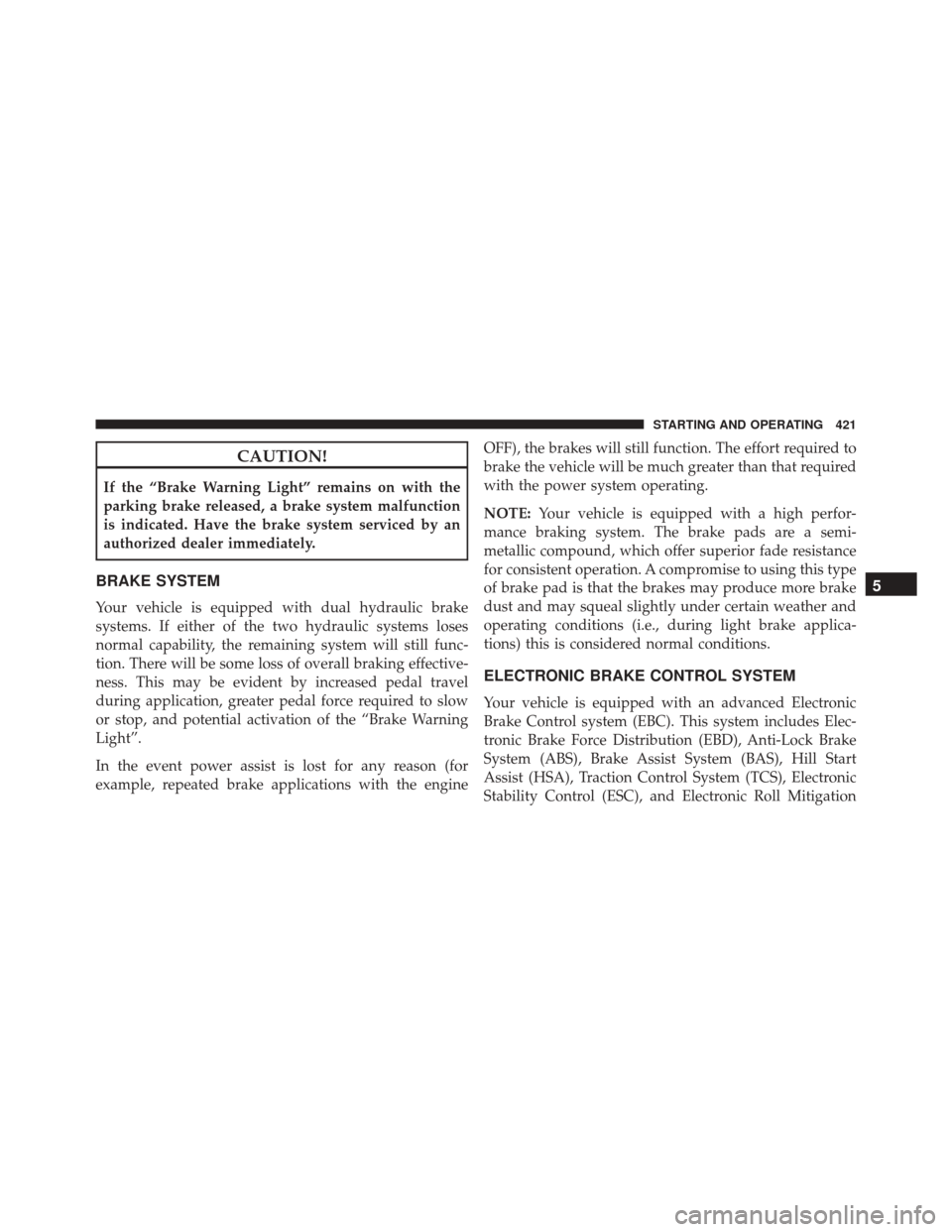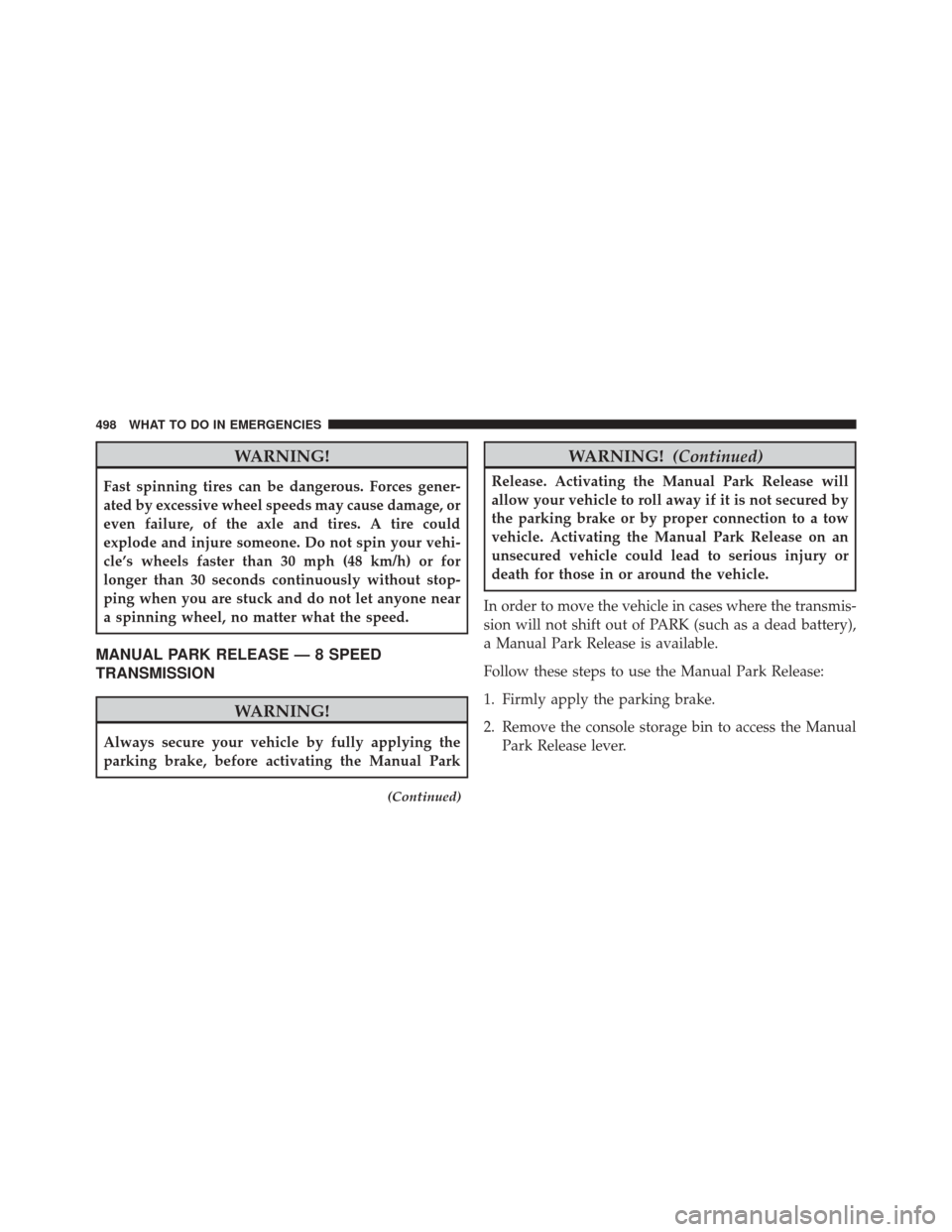Page 423 of 616

CAUTION!
If the “Brake Warning Light” remains on with the
parking brake released, a brake system malfunction
is indicated. Have the brake system serviced by an
authorized dealer immediately.
BRAKE SYSTEM
Your vehicle is equipped with dual hydraulic brake
systems. If either of the two hydraulic systems loses
normal capability, the remaining system will still func-
tion. There will be some loss of overall braking effective-
ness. This may be evident by increased pedal travel
during application, greater pedal force required to slow
or stop, and potential activation of the “Brake Warning
Light”.
In the event power assist is lost for any reason (for
example, repeated brake applications with the engineOFF), the brakes will still function. The effort required to
brake the vehicle will be much greater than that required
with the power system operating.
NOTE:
Your vehicle is equipped with a high perfor-
mance braking system. The brake pads are a semi-
metallic compound, which offer superior fade resistance
for consistent operation. A compromise to using this type
of brake pad is that the brakes may produce more brake
dust and may squeal slightly under certain weather and
operating conditions (i.e., during light brake applica-
tions) this is considered normal conditions.
ELECTRONIC BRAKE CONTROL SYSTEM
Your vehicle is equipped with an advanced Electronic
Brake Control system (EBC). This system includes Elec-
tronic Brake Force Distribution (EBD), Anti-Lock Brake
System (ABS), Brake Assist System (BAS), Hill Start
Assist (HSA), Traction Control System (TCS), Electronic
Stability Control (ESC), and Electronic Roll Mitigation
5
STARTING AND OPERATING 421
Page 429 of 616

WARNING!(Continued)
not be enough brake pressure to hold both the
vehicle and the trailer on a hill when the brake
pedal is released. In order to avoid rolling down an
incline while resuming acceleration, manually ac-
tivate the trailer brake or apply more vehicle brake
pressure prior to releasing the brake pedal.
• HSA is not a parking brake. Always apply the
parking brake fully when leaving your vehicle.
Also, be certain to leave the transmission in PARK.
• Failure to follow these warnings may cause the
vehicle to roll down the incline and could collide
with another vehicle, object or person, and cause
serious or fatal injury. Always remember to use the
parking brake while parking on a hill and that the
driver is responsible for braking the vehicle.
Disabling And Enabling HSA
This feature can be turned on or turned off. To change the
current setting, proceed as follows:
• For vehicles equipped with the Driver Information
Display (DID), refer to “Driver Information Display
(DID)” in “Understanding Your Instrument Panel” for
further information.
• If disabling HSA using Uconnect Settings, refer to
“Uconnect Settings” in “Understanding Your Instru-
ment Panel” for further information.
For vehicles not equipped with the DID, perform the
following steps:
1. Center the steering wheel (front wheels pointing straight forward).
2. Shift the transmission into PARK.
3. Apply the parking brake.
5
STARTING AND OPERATING 427
Page 489 of 616

on the ground. This will provide the best positioning
of the kit when injecting the sealant into the deflated
tire and running the air pump. Move the vehicle as
necessary to place the valve stem in this position
before proceeding.
3. Place the transmission in PARK (auto transmission) or in Gear (manual transmission) and place the ignition
in the OFF position.
4. Set the parking brake.
(B) Setting Up To Use Tire Service Kit:
1. Push in the Mode Select Knob (5) and turn to the Sealant Mode position.
2. Uncoil the Sealant Hose (6) and then remove the cap from the fitting at the end of the hose.
3. Place the Tire Service Kit flat on the ground next to the deflated tire. 4. Remove the cap from the valve stem and then screw
the fitting at the end of the Sealant Hose (6) onto the
valve stem.
5. Uncoil the Power Plug (8) and insert the plug into the vehicle’s 12 Volt power outlet.
NOTE: Do not remove foreign objects (e.g., screws or
nails) from the tire.
(C) Injecting Tire Service Kit Sealant Into The
Deflated Tire:
• Always start the engine before turning ON the Tire
Service Kit.
NOTE: Manual transmission vehicles must have the
parking brake engaged and the gear selector in NEU-
TRAL.
6
WHAT TO DO IN EMERGENCIES 487
Page 496 of 616

WARNING!
•Take care to avoid the radiator cooling fan when-
ever the hood is raised. It can start anytime the
ignition switch is ON. You can be injured by
moving fan blades.
• Remove any metal jewelry such as rings, watch
bands and bracelets that could make an inadvertent
electrical contact. You could be seriously injured.
• Batteries contain sulfuric acid that can burn your
skin or eyes and generate hydrogen gas which is
flammable and explosive. Keep open flames or
sparks away from the battery.
1. Set the parking brake, shift into PARK (automatic transmission) or 1st gear (manual transmission) and
cycle the ignition to OFF.
2. Turn off the heater, radio, and all unnecessary electri- cal accessories. 3. If using another vehicle to jump-start the battery, park
the vehicle within the jumper cables reach, set the
parking brake and make sure the ignition is OFF.
WARNING!
Do not allow vehicles to touch each other as this
could establish a ground connection and personal
injury could result.
Jump-Starting Procedure
WARNING!
Failure to follow this jump-starting procedure could
result in personal injury or property damage due to
battery explosion.
494 WHAT TO DO IN EMERGENCIES
Page 500 of 616

WARNING!
Fast spinning tires can be dangerous. Forces gener-
ated by excessive wheel speeds may cause damage, or
even failure, of the axle and tires. A tire could
explode and injure someone. Do not spin your vehi-
cle’s wheels faster than 30 mph (48 km/h) or for
longer than 30 seconds continuously without stop-
ping when you are stuck and do not let anyone near
a spinning wheel, no matter what the speed.
MANUAL PARK RELEASE — 8 SPEED
TRANSMISSION
WARNING!
Always secure your vehicle by fully applying the
parking brake, before activating the Manual Park
(Continued)
WARNING!(Continued)
Release. Activating the Manual Park Release will
allow your vehicle to roll away if it is not secured by
the parking brake or by proper connection to a tow
vehicle. Activating the Manual Park Release on an
unsecured vehicle could lead to serious injury or
death for those in or around the vehicle.
In order to move the vehicle in cases where the transmis-
sion will not shift out of PARK (such as a dead battery),
a Manual Park Release is available.
Follow these steps to use the Manual Park Release:
1. Firmly apply the parking brake.
2. Remove the console storage bin to access the Manual Park Release lever.
498 WHAT TO DO IN EMERGENCIES
Page 501 of 616
3. Using a small screwdriver or similar tool, fish thetether strap up through the opening in the console
base.
4. Insert the screwdriver into the slot in the center of the lever, and disengage the lever locking tab by pushing
it to the right. 5. While holding the locking tab in the disengaged
position, pull the tether strap to rotate the lever up and
rearward until it locks in place in the vertical position.
The vehicle is now out of PARK and can be moved.
Release the parking brake only when the vehicle is
securely connected to a tow vehicle.
Console Storage BinLocking Tab
6
WHAT TO DO IN EMERGENCIES 499
Page 577 of 616
Miles:6,000
12,000
18,000
24,000
30,000
36,000
42,000
48,000
54,000
60,000
66,000
72,000
78,000
84,000
90,000
96,000
102,000
108,000 114,000
120,000
126,000
132,000
138,000
144,000
150,000
Or Months: 6 12 18 24 30 36 42 48 54 60 66 72 78 84 90 96 102 108 114 120 126 132 138 144 150
Or Kilometers:
10,000
20,000
30,000
40,000
50,000
60,000
70,000
80,000
90,000
100,000
110,000
120,000
130,000
140,000
150,000
160,000
170,000
180,000
190,000
200,000
210,000
220,000
230,000
240,000
250,000
If using your vehicle
for any of the follow-
ing: dusty or off-road
conditions. Inspect the
engine air cleaner fil-
ter; replace if neces-
sary. XXXXXXXXXXXX
Inspect the brake lin-
ings; replace if neces-
sary. XXXXXXXXXXXX
Inspect the CV joints. XXXXXXXXXXXX
Inspect the exhaust
system. XXXXXXXX XXX
Adjust the parking
brake on vehicles
equipped with four
wheel disc brakes. XXXXX
8
MAINTENANCE SCHEDULES 575
Page 596 of 616

Brake Fluid......................... .567, 569
Brake, Parking .......................... .418
Brakes ................................ .421
Brake System ........................ .421, 535
Fluid Check ....................536, 567, 569
Master Cylinder ....................... .536
Parking ............................. .418
Warning Light ..................... .233, 421
Brake/Transmission Interlock .................389
Braking ............................... .266
SRT ................................ .266
Braking Distance ......................... .266
SRT ................................ .266
Brightness, Interior Lights ...................145
Bulb Replacement ..................... .560, 562
Bulbs, Light .......................... .98, 560
Camera, Rear ........................... .195
Capacities, Fluid ...................... .565, 566Caps, Filler
Fuel ................................ .470
Oil (Engine) .......................... .516
Radiator (Coolant Pressure) ................533
Carbon Monoxide Warning ................95, 469
Cargo (Vehicle Loading) ....................472
Car Washes ............................ .541
Center High Mounted Stop Light ..............564
Certification Label ........................ .472
Chains, Tire ............................ .456
Chart, Tire Sizing ........................ .437
Check Engine Light (Malfunction Indicator Light) . .512
Checking Your Vehicle For Safety ...............94
Checks, Safety ............................94
Child Restraint ............................71
Child Restraints Booster Seats ...........................76
Center Seat LATCH ......................84
Child Restraints .........................71
594 INDEX